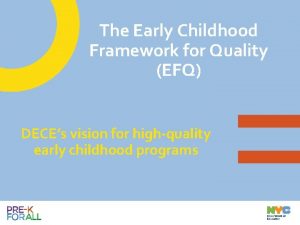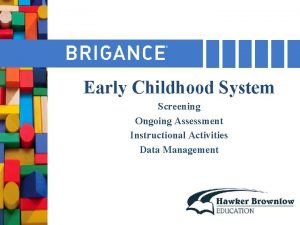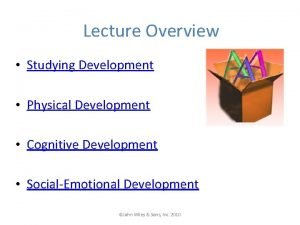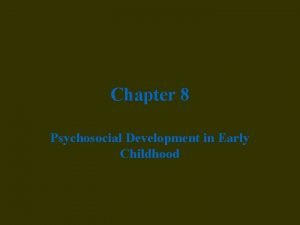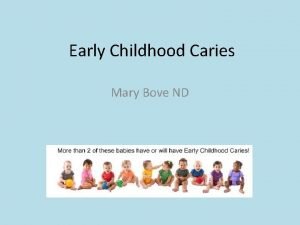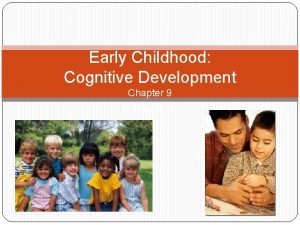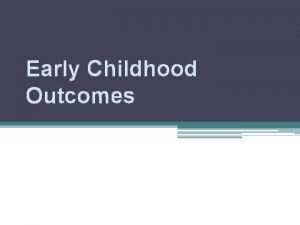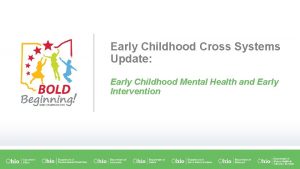Platforms to Reach Children in Early Childhood Maureen












- Slides: 12

Platforms to Reach Children in Early Childhood Maureen M. Black, Amber Gove, and Katherine A. Merseth In Disease Control Priorities, Vol. 3, World Bank RTI International is a registered trademark and a trade name of Research Triangle Institute. www. rti. org

How (and Why) to Reach Children in Early Childhood? Three significant advances: 1. 2. 3. Recognition that adult health and well-being are based on prenatal and early-life genetic and environmental interactions Urgent call for strategies to promote early childhood development Economic growth in the 1990 s and success of the Millennium Development Goals in combating poverty and stunting, which have increased optimism

Nurturing Care, with Associated Risk and Protective Factors Epigenetic processes Biological embedding Poverty Maternal Education Nutrition 8 -9 Years Maternal Stress Beyond Accumulated risks Co-occurrence of risks has spurred recommendations for integrated interventions

Integrated Interventions and Multi-Sectoral Coordination Integrated interventions refers to services that address multiple issues with shared messages, the use of shared or existing platforms, and opportunities for synergy Multi-sectoral coordination refers to coordinated services across sectors, with either sector-specific or unifying policies Issue Benefit Cautionary Note Impact of integrated intervention may be stronger than single sector models Impact of nutrition intervention is strongest in the first 1, 000 days. Impact of child development interventions continues beyond the first 1, 000 days. Economy of effort One community worker may be able to deliver multiple messages. Additional time per visit may be required to deliver multiple messages. Financial support Economy of sharing community workers across sectors. Clarity needed in balancing financial investment and administrative coordination across sectors. International organizations are promoting integrated multi-sector policies Strong policies may result in better quality and more programs that address the comprehensive needs of children. Policy support from international agencies requires program, training, and evaluation support. Existing delivery platform Delivery platforms may vary across sectors, providing additional opportunities to reach participants. Limited data on the impact of varying platforms (such as individual versus group). Evaluation May be efficient to conduct evaluation across multiple domains. Evaluation demands from two sectors. Governance structure may facilitate cross-sectoral coordination. Sectors have separate budgets, priorities, and management targets. Training and supervision could be coordinated across sectors to develop comprehensive, integrated messages. Specialized training and supervision may be necessary to adequately meet the needs of differing domain and sector priorities. Implementation science Principles of implementation science, including stakeholder involvement, can assist with program sustainability and scaling. Additional costs may be incurred to apply principles of implementation science across two sectors.

Equitable Delivery Platforms and the Social Gradient Universal, Selective, Indicated delivery Proportionate universality: “…. programs, services, and policies that are universal, but with a scale and intensity that is proportionate to the level of disadvantage” (Marmot, 2010) Vocabulary Study Human Early Learning Partnership Policy Brief 2015, University of British Columbia

Platforms by sector

Mind the Gap! Age gap in early childhood development (ECD) services between health and education sectors MIND THE GAP

Preconception to Two Years Introduce adolescent education, often a missed opportunity Promote development during infancy Use clinics, home visits, community groups Successful Models Care for Child Development Reach Up Early Childhood Parenting Program (Jamaica) Community groups – Plan Uganda

Preprimary and Primary Schooling Preprimary Global enrollment up MICS data SDG 4. 2 Successful models Madrasa Early Childhood Programme-East Africa Mozambique Primary Expansion of UPE Low levels of learning Lack of global measures

Conclusions Promising gains have been made, but major gaps remain: • Workforce development • Cost-effectiveness data • Population-based indicators • Improved coordination/governance Nurturing care as guiding framework • Age 0 -2 activities should incorporate responsive caregiving/early learning • Age 2 -4 services could be provided through integrated programs and multisector approaches • Standards for quality pre-primary are lacking

Thank You! The contents of this presentation are based on the chapter of the same name in Disease Control Prevention, copyright International Bank for Reconstruction and Development/The World Bank (in press). Contact: Katherine A. Merseth Team Lead, ECD RTI International kmerseth@rti. org Mudze community in Tete, Mozambique

References Marmot Review Team. (2010, February). Fair society, healthy lives: Strategic review of health inequalities in England post-2010 (The Marmot review). London, UK: Department of Health. http: //www. instituteofhealthequity. org/projects/fair-societyhealthy-lives-the-marmot-review University of British Columbia (UBC). (2015). Proportionate universality: 2015 policy brief. Vancouver: Human Early Learning Partnership, UBC. http: //earlylearning. ubc. ca/media/publications/proportionate_universality_web_nove mber_2015. pdf
 Middle childhood years
Middle childhood years Trends in early childhood education
Trends in early childhood education Kentucky governor's office of early childhood
Kentucky governor's office of early childhood Becc brownsburg
Becc brownsburg Eminem early childhood
Eminem early childhood Nyc doe efq
Nyc doe efq Chapter 7 early childhood ages 3 through 5
Chapter 7 early childhood ages 3 through 5 Bf skinner early childhood education
Bf skinner early childhood education Brigance readiness activities
Brigance readiness activities 3 stages of prenatal development
3 stages of prenatal development Psychosocial development in early childhood
Psychosocial development in early childhood Critical reflection in early childhood
Critical reflection in early childhood Bellfort early childhood center
Bellfort early childhood center





